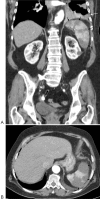Acute Splenic Infarction at an Academic General Hospital Over 10 Years: Presentation, Etiology, and Outcome
- PMID: 26356690
- PMCID: PMC4616622
- DOI: 10.1097/MD.0000000000001363
Acute Splenic Infarction at an Academic General Hospital Over 10 Years: Presentation, Etiology, and Outcome
Erratum in
- Medicine (Baltimore). 2016 Jan;95(2):e2431. Ami, Schattner [corrected to Schattner, Ami]; Meital, Adi [corrected to Adi, Meital]; Ella, Kitroser [corrected to Kitroser, Ella]; Abraham, Klepfish [corrected to Klepfish, Abraham]
-
Erratum: Acute Splenic Infarction at an Academic General Hospital Over 10 Years: Presentation, Etiology, and Outcome: Erratum.Medicine (Baltimore). 2016 Jan 15;95(2):e2431. doi: 10.1097/01.md.0000479777.75424.31. eCollection 2016 Jan. Medicine (Baltimore). 2016. PMID: 31265577 Free PMC article.
Abstract
Few case series provide a current, comprehensive, and detailed description of splenic infarction (SI), an uncommon condition.Retrospective chart review complemented by imaging evaluation and patient follow-up.All adult patients with a confirmed diagnosis of acute SI discharged over 10 years from a single academic center were studied. A systematic literature review was done to compile a complete list of SI etiologies.SI was found in 32 patients, 0.016% of admissions. Ages ranged from 18 to 86 (median 64) years. Cardiogenic emboli were the predominant etiology (20/32, 62.5%) and atrial fibrillation was frequent. Other patients had autoimmune disease (12.5%), associated infection (12.5%), or hematological malignancy (6%). Nine of the patients (28%) had been previously healthy or with no recognized morbidity predisposing to SI. In 5 of 9 hitherto silent antiphospholipid syndrome or mitral valve disease had been identified. Two remained cryptogenic. Most patients presented with abdominal pain (84%), often felt in the left upper quadrant or epigastrium. Associated symptoms, leukocytosis or increased serum lactate dehydrogenase occurred inconsistently (∼25% each). Chest X-ray showed suggestive Lt. supra-diaphragmatic findings in 22%. Thus, the typical predisposing factors and/or clinical presentation should suggest SI to the clinician and be followed by early imaging by computed tomography (CT), highly useful also in atypical presentations. Complications were rare and patients were discharged after 6.5 days (median) on anticoagulant treatment. The systematic literature review revealed an extensive list of conditions underlying SI. In some, SI may be the first and presenting manifestation.SI is a rare event but should be considered in predisposed patients or those with any combination of suggestive clinical features, especially abdominal pain CT evaluation is diagnostic and the outcome is good.
Conflict of interest statement
The authors have no funding and conflicts of interest to disclose.
Figures
References
-
- Kumar V, Abbas AK, Fausto N, Aster J. Diseases of white blood cells, lymph nodes, spleen, and thymus. In: Robbins and Cotran Pathologic Basis of Disease. 8th ed. Philadelphia: Saunders Elsevier; 2010.
-
- Wilkins BS. The spleen. Br J Hematol 2002; 117:265–274. - PubMed
-
- Austin SK, Lambert JR. The JAK2 V617F mutation and thrombosis. Br J Hematol 2008; 143:307–320. - PubMed
-
- Colaizzo D, Amitrano L, Guardascione MA, et al. Outcome of patients with splanchnic venous thrombosis presenting without overt MPN: a role for the JAK2 V617F mutation re-evaluation. Thromb Res 2013; 132:e99–e104. - PubMed
-
- Kocher KE, Meurer WJ, Fazel R, et al. National trends in use of computed tomography in the emergency department. Ann Emerg Med 2011; 58:452–462. - PubMed
Publication types
MeSH terms
Substances
LinkOut - more resources
Full Text Sources
Medical


